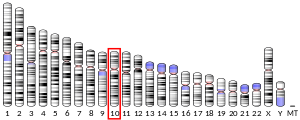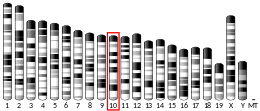Protein-coding gene in the species Homo sapiens
| ARID5B |
|---|
 |
| Available structures |
|---|
| PDB | Ortholog search: PDBe RCSB |
|---|
| List of PDB id codes |
|---|
1IG6, 2OEH |
|
|
| Identifiers |
|---|
| Aliases | ARID5B, DESRT, MRF-2, MRF2, AT-rich interaction domain 5B |
|---|
| External IDs | OMIM: 608538; MGI: 2175912; HomoloGene: 45872; GeneCards: ARID5B; OMA:ARID5B - orthologs |
|---|
| Gene location (Human) |
|---|
 | | Chr. | Chromosome 10 (human)[1] |
|---|
| | Band | 10q21.2 | Start | 61,901,684 bp[1] |
|---|
| End | 62,096,944 bp[1] |
|---|
|
| Gene location (Mouse) |
|---|
 | | Chr. | Chromosome 10 (mouse)[2] |
|---|
| | Band | 10|10 B5.1- B5.2 | Start | 67,928,350 bp[2] |
|---|
| End | 68,114,570 bp[2] |
|---|
|
| RNA expression pattern |
|---|
| Bgee | | Human | Mouse (ortholog) |
|---|
| Top expressed in | - beta cell
- saphenous vein
- pericardium
- vena cava
- urethra
- parietal pleura
- decidua
- mucosa of urinary bladder
- lactiferous duct
- superficial temporal artery
|
| | Top expressed in | - zygote
- left lung lobe
- stroma of bone marrow
- Paneth cell
- ciliary body
- secondary oocyte
- decidua
- ascending aorta
- ureter
- vas deferens
|
| | More reference expression data |
|
|---|
| BioGPS | |
|---|
|
| Gene ontology |
|---|
| Molecular function | - DNA binding
- RNA polymerase II transcription regulatory region sequence-specific DNA binding
- transcription coactivator activity
- protein binding
- DNA-binding transcription repressor activity, RNA polymerase II-specific
- histone demethylase activity
- DNA-binding transcription factor activity, RNA polymerase II-specific
| | Cellular component | | | Biological process | - regulation of transcription, DNA-templated
- negative regulation of transcription by RNA polymerase II
- transcription, DNA-templated
- liver development
- negative regulation of transcription, DNA-templated
- histone demethylation
- kidney development
- nitrogen compound metabolic process
- male gonad development
- female gonad development
- post-embryonic development
- fibroblast migration
- adrenal gland development
- multicellular organism growth
- fat cell differentiation
- platelet-derived growth factor receptor signaling pathway
- cell development
- muscle organ morphogenesis
- skeletal system morphogenesis
- positive regulation of DNA-binding transcription factor activity
- roof of mouth development
- face morphogenesis
- adipose tissue development
- fat pad development
- cellular response to leukemia inhibitory factor
- positive regulation of nucleic acid-templated transcription
- regulation of transcription by RNA polymerase II
| | Sources:Amigo / QuickGO |
|
|
| Wikidata |
| View/Edit Human | View/Edit Mouse |
|
AT-rich interactive domain-containing protein 5B is a protein that in humans is encoded by the ARID5B gene.[5][6][7]
Alternative names for this gene include Modulator recognition factor 23.
Genomics
The gene is located on the long arm of chromosome 10 (10q21.2) on the 'plus' strand. It spans 195,261 base pairs in length. It encodes a protein of predicted length and molecular weight of 1188 amino acids and 132.375 kilodaltons respectively.
Clinical importance
Through genome wide association studies (GWAS),some of the single nucleotide polymorphisms (SNPs) located in this gene has been noticed to be significantly associated with susceptibility [8][9][10] as well as treatment outcomes [11] of childhood acute lymphoblastic leukaemia in ethnically diverse populations.
References
- ^ a b c GRCh38: Ensembl release 89: ENSG00000150347 – Ensembl, May 2017
- ^ a b c GRCm38: Ensembl release 89: ENSMUSG00000019947 – Ensembl, May 2017
- ^ "Human PubMed Reference:". National Center for Biotechnology Information, U.S. National Library of Medicine.
- ^ "Mouse PubMed Reference:". National Center for Biotechnology Information, U.S. National Library of Medicine.
- ^ Lahoud MH, Ristevski S, Venter DJ, Jermiin LS, Bertoncello I, Zavarsek S, Hasthorpe S, Drago J, de Kretser D, Hertzog PJ, Kola I (Aug 2001). "Gene targeting of Desrt, a novel ARID class DNA-binding protein, causes growth retardation and abnormal development of reproductive organs". Genome Research. 11 (8): 1327–34. doi:10.1101/gr.168801. hdl:10536/DRO/DU:30121320. PMID 11483573.
- ^ Zhu L, Hu J, Lin D, Whitson R, Itakura K, Chen Y (Aug 2001). "Dynamics of the Mrf-2 DNA-binding domain free and in complex with DNA". Biochemistry. 40 (31): 9142–50. doi:10.1021/bi010476a. PMID 11478881.
- ^ "Entrez Gene: ARID5B AT rich interactive domain 5B (MRF1-like)".
- ^ Xu H, Yang W, Perez-Andreu V, Devidas M, Fan Y, Cheng C, et al. (May 2013). "Novel susceptibility variants at 10p12.31-12.2 for childhood acute lymphoblastic leukemia in ethnically diverse populations". Journal of the National Cancer Institute. 105 (10): 733–42. doi:10.1093/jnci/djt042. PMC 3691938. PMID 23512250.
- ^ Treviño LR, Yang W, French D, Hunger SP, Carroll WL, Devidas M, et al. (September 2009). "Germline genomic variants associated with childhood acute lymphoblastic leukemia". Nature Genetics. 41 (9): 1001–5. doi:10.1038/ng.432. PMC 2762391. PMID 19684603.
- ^ Papaemmanuil E, Hosking FJ, Vijayakrishnan J, Price A, Olver B, Sheridan E, et al. (September 2009). "Loci on 7p12.2, 10q21.2 and 14q11.2 are associated with risk of childhood acute lymphoblastic leukemia". Nature Genetics. 41 (9): 1006–10. doi:10.1038/ng.430. PMC 4915548. PMID 19684604.
- ^ Xu H, Cheng C, Devidas M, Pei D, Fan Y, Yang W, et al. (March 2012). "ARID5B genetic polymorphisms contribute to racial disparities in the incidence and treatment outcome of childhood acute lymphoblastic leukemia". Journal of Clinical Oncology. 30 (7): 751–7. doi:10.1200/JCO.2011.38.0345. PMC 3295551. PMID 22291082.
External links
Further reading
- Yuan YC, Whitson RH, Liu Q, Itakura K, Chen Y (Nov 1998). "A novel DNA-binding motif shares structural homology to DNA replication and repair nucleases and polymerases". Nature Structural Biology. 5 (11): 959–64. doi:10.1038/2934. PMID 9808040. S2CID 10099806.
- Whitson RH, Huang T, Itakura K (May 1999). "The novel Mrf-2 DNA-binding domain recognizes a five-base core sequence through major and minor-groove contacts". Biochemical and Biophysical Research Communications. 258 (2): 326–31. doi:10.1006/bbrc.1999.0643. PMID 10329386.
- Patsialou A, Wilsker D, Moran E (2005). "DNA-binding properties of ARID family proteins". Nucleic Acids Research. 33 (1): 66–80. doi:10.1093/nar/gki145. PMC 546134. PMID 15640446.
- Olsen JV, Blagoev B, Gnad F, Macek B, Kumar C, Mortensen P, Mann M (Nov 2006). "Global, in vivo, and site-specific phosphorylation dynamics in signaling networks". Cell. 127 (3): 635–48. doi:10.1016/j.cell.2006.09.026. PMID 17081983. S2CID 7827573.
 | This article on a gene on human chromosome 10 is a stub. You can help Wikipedia by expanding it. |

 1ig6: HUMAN MRF-2 DOMAIN, NMR, 11 STRUCTURES
1ig6: HUMAN MRF-2 DOMAIN, NMR, 11 STRUCTURES

















